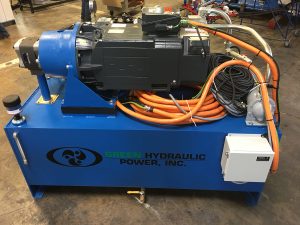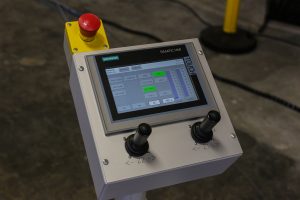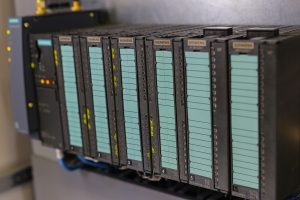
The Green Hydraulic Power unit, designed by MJC Engineering, reports energy savings up to 70%. This earns users energy credits from their home states.
MJC Engineering is a custom machine tool builder in Huntington Beach, Calif., specializing in metal-spinning machines for sheet spinning, flow forming, wheel spinning and others. MJC machines typically use large volumes of hydraulic power in operation.
About three years ago, the president at MJC, Carl Lorentzen, began investigating the configuration of the hydraulic units used on his company’s machinery. Lorentzen was interested in servo-pump technology, having read about its application in other industrial uses.
“We had looked at a variety of ways to improve the energy efficiency of our machines. Being a California company, there are substantial incentives offered here for documented energy savings in machine building and operations. Plus, I felt it was simply the right course of action to do our part in protecting natural resources,” said Lorentzen. He also cited a recent incident where MJC changed insurance carriers and, as part of the company safety audit, sound levels were tested and the hydraulic power units were a concern.
All these factors caused a “light bulb moment” for the builder. MJC began serious investigation into the application of servo-pump technology to replace the constant motor operation on the main hydraulic unit of the machines, in a concerted effort to reduce energy consumption, noise and, owing to the smaller hydraulic reservoirs needed, the machine footprint.

Control panel with touchscreen operation and joysticks
These definable upsides for MJC machine design caused considerable excitement for Lorentzen, who noted, “All these engineers had the same reaction I did and we began to rethink our hydraulic power units from the ground up.”
Lorentzen turned to his longtime supplier of CNC, PLC and drives technology, Siemens, for further assistance. A team led by Chris Britton, the Siemens sales manager for the region, assisted with various application engineering studies, energy and controls testing to affect the optimum design, all while working in concert with the MJC team.
Britton explained, “Carl’s company uses a wide variety of motion controls and components on their machine builds, including CNC, PLC, motors, spindles, power modules and our drive control chart (DCC) technology that allows configuring of all the control loop structures.”
A further advantage quickly emerged, as the Green Hydraulic Power unit (GHP) began to take shape. Little or no external cooling was required to dissipate the ambient heat of the unit. From the OEM perspective, MJC benefitted from the conceptualization, engineering and commissioning tools offered by Siemens during the build-up of the GHP units. Siemens SIZER software, for example, orchestrated the integrated data across the entire platform of drives technology, enabling the MJC engineering team to match the most suitable products to the specific requirements of the end user applications, with a drastic reduction in the engineering time on subsequent unit designs. M-CAD likewise enabled the importing of all motor specifications to match the requirements of each job.
Additionally, TIA Portal has faster commissioning, increases productivity and facilitates comprehensive data capture, which benefits both operations/maintenance personnel and the integration of the data into a “digital factory” mode, as the system’s condition monitoring and diagnostics can reside in the cloud or otherwise be networked to a controls communication stream. Depending on the drives technology selected, it is also possible for the end user to perform online configuration of the drives via their web server. GKN Aerospace in Orangeburg, S.C. was the first customer for whom an entirely new MJC spinforming machine was built, using a complete and now duly named Green Hydraulic Power unit. MJC’s Vice-President Per Carlson and his hydraulic engineer Jerry Wang designed the unit. An already documented result of the GHP unit onboard its machine, GKN has experienced nearly a 70% energy consumption savings, plus the quieter operation and smaller footprint.
Following this development, Lorentzen also realized the unit could easily be adapted onto any type of heavy hydraulic piece of equipment. Subsequently, he established Green Hydraulic Power Inc., which today functions as a free-standing enterprise.

Wireless panel operation for easy
movement by operator
As MJC electrical engineer and robotics manager Jose Machuca explained, “The GHP is a complete turnkey system with I/O options to run with any PLC, to control the power on virtually any type of hydraulically-powered machine. We researched the variable speed drive hydraulics for over two years to devise the optimum solution on our current standard models, which comprise 15, 30, 55 and 80 kW units.”
Lorentzen further added, “Nobody is offering a closed-loop, engineered system like the GHP for integration onto a customer’s machine, with practically no impact on that machine’s design. It quickly became clear to us we had a real gem here, as GHP can be used as an OE component or retrofit onto an existing piece of machinery in the field. That includes practically every machine we’ve built ourselves.”
“We had a very dynamic interaction with the Siemens engineering team to make this unit come alive,” said Machuca. “We frankly didn’t know what to expect at the outset, but the results have been very pleasing so far. And we’ve only just begun.”
Further options under development for GHP include Scalance wireless control, kW torque setpoint on pressure, fail-safe compatibility, custom touchscreen and other monitoring and maintenance tools for operation and unit data transmission in an Industry 4.0 environment, over a Profinet industrial Ethernet protocol.
When equipped with a high-level Safety Integrated PLC and other required components, the GHP is suitable for severe environments such as oil rigs, chemical processing equipment and other challenging work environment applications.
Siemens
siemens.com
Filed Under: Fluid Power Basics, Slider